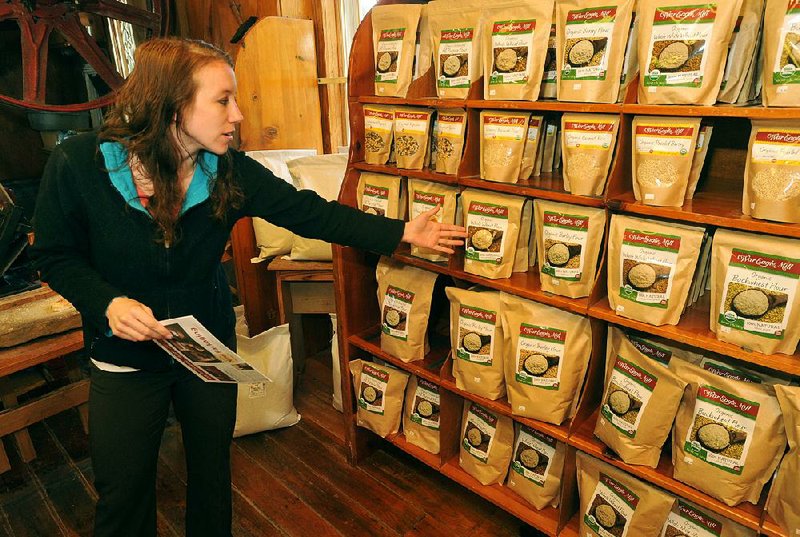ROGERS - When customers visiting War Eagle Mill cross over a one-lane bridge that spans a rushing river, it’s easy to forget that the bags of flour sold there are more than just a local commodity picked up on a lark by tourists and hardcore bakers.
Nowadays, organic flours and meals are ground by War Eagle Mill, along with grains and cereals and products like cornbread and soup mixes. The products are sold in Wal-Mart and Harps stores in Northwest Arkansas, the three Whole Foods outlets in Arkansas, numerous mom-and-pop stores regionally, restaurants throughout the U.S., and online.
That’s why a new branding campaign for the Mill’s products was vital, said Liz Kapsner, sales and market-ing coordinator.
The Mill’s signature calico bag, which had been around since the 1970s, and its hodgepodge labeling was scrapped. In its place is a more modern, color-coded system that is visual and uniform, all displayed on a resealable artisan craft bag to keep the contents fresh. The products now are sold in only 2-pound, 5-pound and 25-pound bags.
“There wasn’t a lot of consistent branding in the past,” said Kapsner.
The new bags and branding came at the insistence of owner Elise Roegnik, who oversaw the shift. The new packages and branding were released this month, after a year of study that included consulting focus groups and market surveys.
The new bags have flat bottoms so they stand up on their own for easy use. Flours, color-coded green, feature a picture of a wooden spoon filled with the product with the milled grain in the background. The grain packages with yellow on the label have a see-through window. Mixes (coded blue) and soups (purple) feature a picture of the product. All have recipes included.
“It catches the eye. It stops people,” Kapsner said. “Now customers are looking at the image, rather than trying to read our labels.”
Martin Thoma, principal at Little Rock-based Thoma Thoma, a brand leadership firm, and author of Branding Like the Big Boys, said War Eagle Mill’s new brandingis responsive to how people use and buy products today. Consistency is critical in establishing any brand, he said.
“It’s not without risk,” Thoma said of organizations that shift branding.”
Companies must always balance two ideas - what they have been and what they are becoming.”
Kapsner said there has been some customer push back for abandoning the old calico bags, but it’s been gentle. She said some of the Mill’s older customers reused the bags for sewing projects, quilts in particular. She said many of the Mill’s newer customers don’t sew and didn’t know what to do with the old calico bags.
She said it was an important part of the new packaging to inform customers which of the Mill’s products were organic or made without genetically modified organisms,
“People want to know where their food is coming from,” Kapsner said.
Sales of organic products, both food and non-food, accounted for $31.4 billion in the United States in 2011, a 9.5 percent increase compared to 2010, according to the Organic Trade Association, an organization for organic agriculture and products. Organic food accounted for a vast majority of sales at $29.2 billion, and showed 9.4 percent growth in 2011, the most recent data available. Organic food made up 4.2 percent of total food sales in the U.S.
According to a recent survey, 2013 U.S. Families’ Organic Attitudes and Beliefs Study, organic produce is the leading category in organic sales followed closely by breads and grains, dairy and packaged foods. Organic buyers tend to spend more with retailers and purchase more each trip, according to the study done by the association in cooperation with KIWI Magazine - which focuses on a green and organic lifestyle for families.
War Eagle Mill employs 25 workers across all its operations. While its waterwheel-driven mill is fully functioning and can grind 250 pounds of product in a day, the majority of the company’s offerings are produced at its nearby grainery granary. In 2012, the company produced and packaged 179,000 pounds of product, including flours, meals and whole grain. The Mill’s biggest seller is yellow cornmeal, with 17,000 pounds sold, followed closely by yellow grits at 14,000 pounds.
War Eagle Mill’s waterwheel was refurbished over the winter. The Mill’s first floor features the newly branded products, prominently displayed, along with jams, jellies and cookware; the second floor houses the gift shop; and the third floor houses the renovated Bean Palace Restaurant, which is known for its beans and cornbread.
Business, Pages 23 on 04/23/2013
